![敲打鍵盤 [敲打鍵盤]](https://jedi.org/blog/icons/icon_typing_48.png) 運用行為模型及動機諮商工具以促進親和力
運用行為模型及動機諮商工具以促進親和力
稍早我跟隨設計制度總顧問邱慕安的腳步,在國際政府設計 24 小時遠端研討會上,分享 PDIS 這一年來的經驗。
儘管我測試、演練了好幾輪,到我要開始的那一刻,瀏覽器硬生生地跳出異常、無法存取我的攝影鏡頭,最後我只能以投影片畫面搭配純語音的形式完成分享(我還忘記關閉鏡頭設備,整個分享期間都顯示著設備異常畫面,真是太糗了),處理瀏覽器期間也幸虧有慕安協助撐場,各位觀看重播時就會看到我有多糗,請多包容。
我分享的主題是「運用行為模型及動機諮商工具以促進親和力 (Applying behavioral model and motivation toolkit to improve accessibility)」,有興趣的朋友可以下載 PPTX 格式的簡報投影片,我以 CC0 公眾授權方式,將這份簡報投影片貢獻至公眾領域。
這份投影片經過親和力檢查,所有的圖片或圖案均加上替代文字,確認過每一頁內的文件報讀順序正確合理,且所有文字內容與背景色彩均達到充分對比(部分文字以加框線的方式來提昇對比)。萬一使用上仍然遭遇障礙,敬請讓我知道。
投影片內容以及我的分享內容都是英文,這篇部落格則提供華語翻譯,讓更多人知道我分享了什麼。

Hello everyone, I'm Mu-An's colleague, Jedi Lin, the Head of Accessibility Design in Public Digital Innovation Space. I'll share my experience about applying the behavioral model and motivation toolkit to improve accessibility in government agencies.
大家好,我是慕安的同事林克寰,在行政院公共數位創新空間 (Public Digital Innovation Space, PDIS) 擔任無障礙設計總顧問。我將分享如何運用行為模型及動機諮商工具,對政府機關促進親和力。
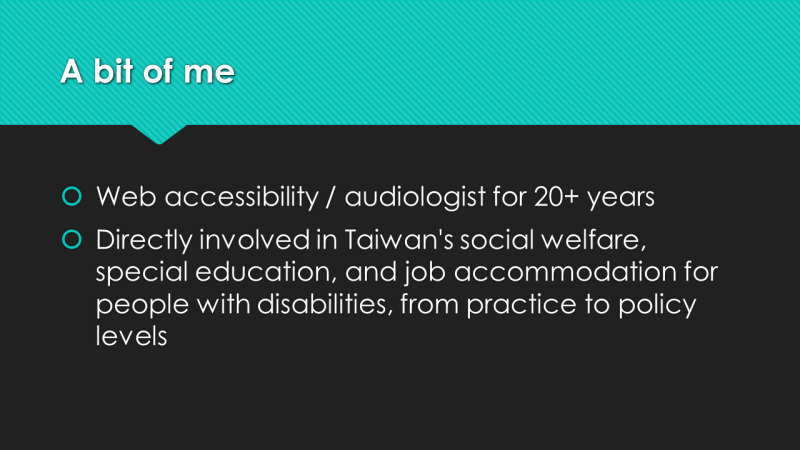
I am a web accessibility consultant and audiologist for more than twenty years. My prior work experience is directly involved in Taiwan's social welfare, special education, and job accommodation for people with disabilities, from the practice level as a care-giver, to the policy level as a committee member and policy draft editor.
我從事網頁親和力顧問及聽力師工作超過二十年,直接參與過台灣身心障礙者的社會福利、特殊教育、職務再設計等領域,我擔任過第一線的服務提供者,直接在實務層級參與,也擔任過委員會成員及政策草案編輯,在政策層級參與。
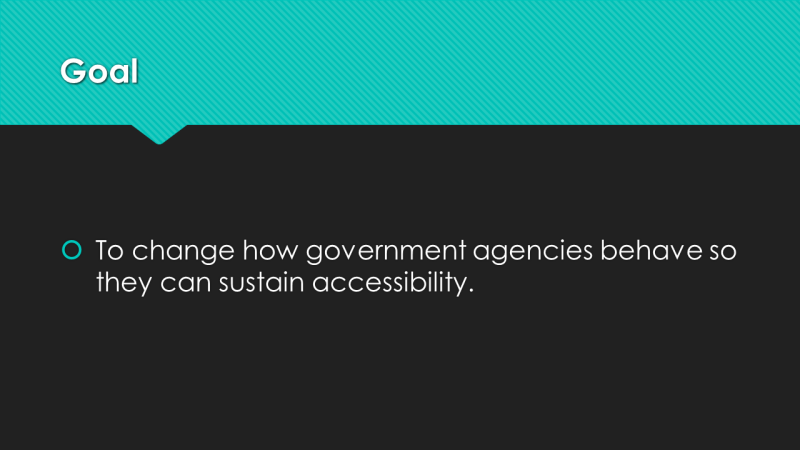
In PDIS, one of our goal is to change how government agencies behave so they can grow and sustain accessibility. We want accessibility to be the corner stone of our policies and culture.
我們在 PDIS 的目標包括要改變政府機關的行事方式,讓政府機關能夠生育滋養親和力。我們想要讓親和力成為我們的政策及文化基石。

We face many challenges. Government agencies don't always do what they claim. They may claim they value the participation of people with disabilities, yet practice segregation. For example, some agencies provide accessible service with very limited functionality compared to inaccessible ones. People with disabilities are forced to process transactions at the counter, in person, accompanied by someone without disabilities. These agencies see this as their success because they can "protect and serve" people with disabilities better. That's really bad. Some government agencies don't know what they are doing. When asking them what their website is built for, they literally reply they don't know, maybe their commander ordered one, or just because "everybody has one, we should too." They know nothing about who will use their services or how. We also see lots of conflicts inside these agencies. Every department has different preferences and priorities, and thinks the responsibility belongs to another department. Everyone in the agencies thinks they are doing their job well by the book and by the order. Anything beyond that is beyond them.
我們面臨到許多挑戰。政府機關不總是言行一致,例如政府機關可能宣稱注重身心障礙者參與,實際上卻實施隔離手段,像是有些政府機關提供的無障礙服務只包含非常有限的功能,更多功能只提供成有障礙的服務,導致身心障礙者往往被迫要在非身心障礙者陪伴下,親自臨櫃辦理事務。這些機關把這個情況視為成功而沾沾自喜,因為他們覺得如此可以提供身心障礙者更好的「保護及服務」。這真的很糟。
有些政府機關不知道自己在做什麼,當問到網站的設置目的,他們真的回答說不知道,或者說是長官指示要架設,或者「因為別人有,我們也要有」。這些政府機關對於哪些人會來使用他們的服務、怎麼使用皆一無所知。
我們也觀察到政府機關內經常有著眾多衝突矛盾。每個部門都有不同的偏好及優先考量,總是認為相關責任應該歸屬到其他部門;機關內的每個公務員都覺得自己依照行政規章及長官指示認真執行公務,除此之外都不是他們的權責範圍。
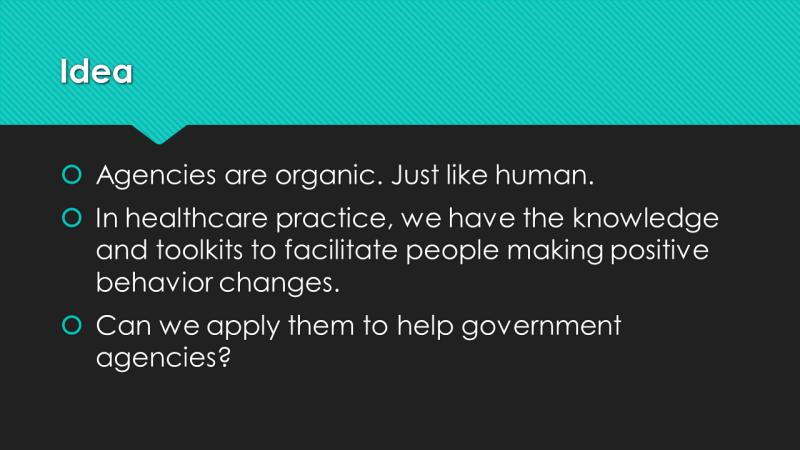
What do I think? I can see these government agencies are organic. Just like humans. Humans don't always do what we claim. Humans don't always know what we are doing. We want a healthy life yet stay up late, or drink and eat too much, or never exercise. From my experience in healthcare practice, we have the knowledge and toolkits to facilitate people making positive behavior changes. I know how to help people treat their hearing loss with hearing aids, for instance. How can we apply these knowledge and toolkits to help government agencies treat their accessibility barrier?
我如何看待這一切呢?從我的眼光中,這些政府機關其實都是某種有機體,就跟人類一樣。人類不總是言行一致、不總是知道自己在做什麼,我們想要健康的生活,偏偏又經常熬夜、暴飲暴食、毫不運動。在我從事健康照護的工作經驗中,我們已經具備足夠的知識及工具,能夠協助大家做出正向行為改變,例如我很清楚知道怎麼幫助大家用助聽器來治療聽力損失。我們要怎麼運用這些知識及工具,幫助政府機關治療這些親和力阻礙?
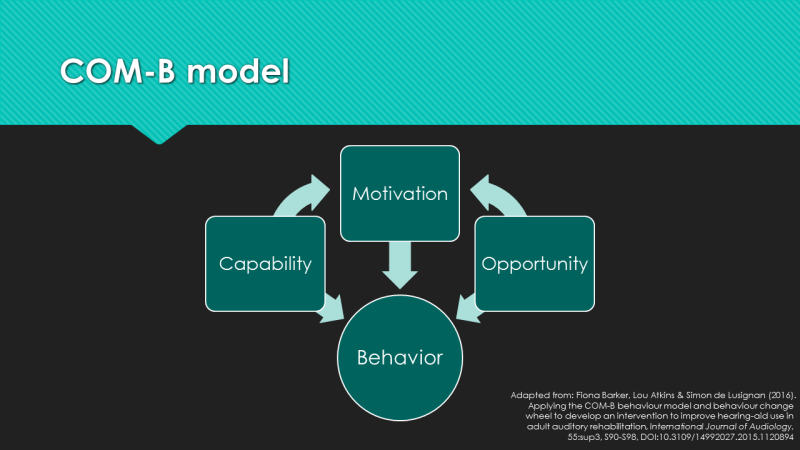
Let me introduce the COM-B model. The COM-B model is a behavioral model widely adopted in many areas, such as to form an exercise habit, to quit smoking, et cetera. This model illustrates that it takes Capability, Opportunity, and Motivation to perform a certain Behavior or behavior change. Please notice that Capability and Opportunity can improve Motivation too. For any government agency, Capability includes its funding, human resource, knowledge, and skills. Opportunity might be people's demand, study or news report event, higher policy issued or changed, even upcoming election. We can work on Capability and Opportunity, but in the end, it's Motivation that matters. After all, if the agency doesn't want to be helped, nothing we work on Capability and Opportunity works.
請讓我介紹 COM-B 行為模型,這個模型被廣泛用於多個領域,例如用以養成運動習慣、戒菸等等。這個模型表示出任何人都需要有能力 (Capability)、機會 (Opportunity)、動機 (Motivation) 才能進行特定的行為 (Behavior) 或做出行為改變。請注意能力及機會也能促進動機。
對於任何政府機關,所謂的能力包括經費預算、人力資源、知識、技能等,而機會可能是民眾提出訴求、研究報告或新聞報導、高層政策實施或變動、即將發生的選舉等。我們可以設法增加能力及機會,但最終還是要看動機。畢竟,如果政府機關不希望獲得幫助,我們在能力及機會方面努力再多也沒用。

The same problem exists in human too. In healthcare area, studies showed the most effective and reliable method is PCC, Person-Centered Care. In PCC practice, patients actively participate in their treatment in close cooperation with their health professionals. The PCC practice has four principles: The treatment is based on the unique person's needs. The treatment focuses on the abilities of the person and encourage activity. The treatment is coherent. Health professionals approach patients with dignity, compassion, and respect. Now, let's think of organic government agency as a person. We'd like to have the agency actively participate in its improvement plan in close cooperation with us. The plan shall be based on the unique agency's needs. The plan shall focus on the current Capability of the agency and encourage activity for known Opportunity. The plan shall mean something to the agency, echo its value, and contribute to its mission. We shall approach the agency with dignity, compassion, and respect. We have to learn its history, culture, politiics, and work with that. We don't plot the plan but facilitate the agency to make its own.
在人類身上也有同樣的困難。健康照護領域的研究指出,最有效且可靠的方式是實施以人為本的照護服務 (Person-Centered Care, PCC)。在 PCC 的照護模式中,患者與健康照護專家緊密合作,積極參與自己的治療處遇計畫。PCC 照護模式有四項原則:
- 應基於獨特個人的需求進行治療處遇
- 治療處遇應著重於個人的能力,並鼓勵活動
- 治療處遇應連貫一致
- 健康照護專家應以尊嚴、同情、尊重的態度對待患者
現在讓我們把政府機關當成一個人。我們希望政府機關能跟我們緊密合作,積極參與自己的改善方案,這個改善方案應該基於獨特機關的需求來規畫實施,著重於機關現有的能力,鼓勵對已知機會進行活動;這個改善方案應對機關具有實質意義,能夠呼應機關的價值,促進機關達成使命。我們應該以尊嚴、同情、尊重的態度來對待政府機關,這表示我們需要學習各機關的歷史脈絡、文化、政治關係等,納入相關考量。我們不是要替政府機關規畫改善方案,而是要協助政府機關訂定自己的改善方案。
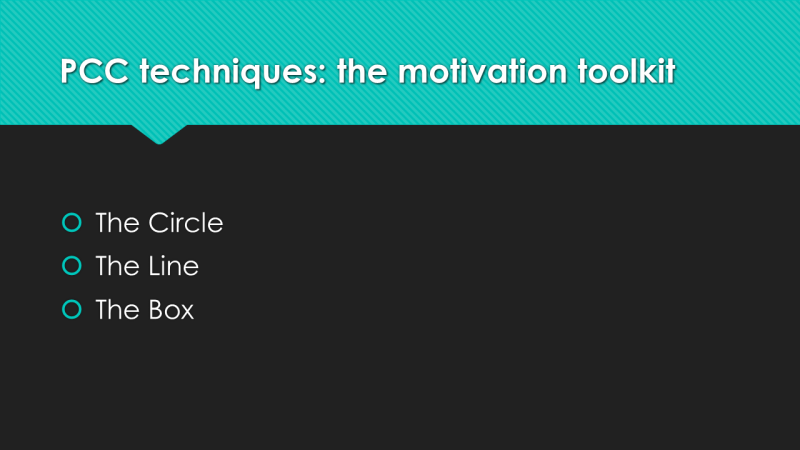
As to Motivation, there is an available motivation toolkit in Person-Centered Care. The toolkit contains the Circle, the Line, and the Box. Let's see how to use them.
至於動機的部份,在 PCC 照護模式中有套動機諮商工具組可以運用,這套工具組包含:圓圈、線條、方格。讓我們來看看這套工具組要怎麼派上用場。
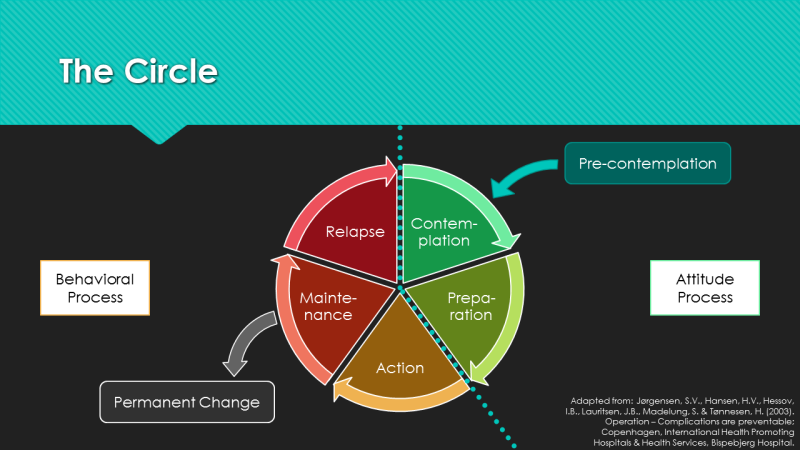
The Circle illustrates the different phases of behavior change. The first phase is Contemplation, followed by Preparation, Action, Maintenance, and Relapse. Each phase leads to the next, forming a circle, with Maintenance phase may leading to Permanent Change if lucky. Before Contemplation, there is phase zero, Pre-contemplation. When we visit a certain government agency, we check which phase it is currently at. Then we can know how to provide help. Pre-contemplation, Contemplation, and Preparation phase belong to the Attitude Process. These three phases focus on attitude change. It's about IF and WHY; there is no need to rush action. Action, Maintenance, and Relapse phase belong to the Behavioral Process. These three phases focus on behavior change. It's about HOW and WHAT, about action and actual doing. Now, how do we know which phase a certain agency is at?
圓圈是一個描繪行為改變階段的參考框架。從意圖期開始,接下來是準備期、行動期、維持期、故態復萌,每個階段推進至下一個階段,形成一個圓圈。如果幸運的話,維持期也可能推進到持久改變 (Permanent Change) 階段。另外,在意圖期前面還有個第零階段:意圖前期。
當我們與某個政府機關相遇的時候,我們會判斷這個機關目前處於改變的哪個階段,然後就能知道要如何提供協助。
意圖前期、意圖期、準備期屬於行為改變的態度歷程 (Attitude Process),這三個階段專注於態度的改變,著重於是否要改變以及為什麼要改變,沒有必要在這些階段催促著一定要做什麼行為不可。
行動期、維持期、故態復萌屬於行為改變的行為歷程 (Behavioral Process),這三個階段專注於行為的改變,著重於如何改變以及改變什麼,也就是行動跟作為的部份。
那麼,究竟我們要如何得知政府機關處於行為改變的哪個階段?
![Slide: [Phase 0] Pre-contemplation](https://jedi.org/blog/archives/ABMAMTTIA-10.png)
If the agency says, "we don't have a problem," then we know there is a huge problem. This is phase zero, Pre-contemplation, where the agency doesn't have the idea at all. In this phase, we review the feedback from actual users with them, and explore the barriers of current services. Sometimes the barriers are so profound that no one can report the existence of the barriers. We show them how people use the web or services, let them be aware there are different users, have different abilities, challenges, and needs. We provide education and awareness in this phase. If the agency is aware their systems or services don't cover all the users, they move into the next phase.
如果政府機關宣稱「我們沒有問題」,那我們就知道問題嚴重了。這就是第零階段:意圖前期 (Pre-contemplation) 的表現,處於這個階段的政府機關缺乏最基本的意圖。對於這個階段,我們會跟政府機關一起回顧系統實際使用者的真實回饋,探索現有服務所存在的各種障礙;有時候這些障礙之巨大,導致根本沒有人能夠回報障礙的存在。
我們會向政府機關展示大家如何使用網頁或政府服務,讓政府機關感知到有各式各樣不同的使用者,其能力、挑戰、需求各有不同。我們在這個階段提供教育及覺識,如果政府機關開始覺得自己的系統或服務尚無法涵蓋所有使用者,就能進入下一個階段。
![Slide: [Phase 1] Contemplation](https://jedi.org/blog/archives/ABMAMTTIA-11.png)
Phase one, Contemplation, is when the agency says, "our service might need to be accessible." The agency in this phase is usually a bit confused. They have ambivalence on whether pursuing accessibility. We listen to them, provide information to explore, clearify, support, and enhance their experience. Then we use the next motivation tool, the Line, to explore their ambivalence and motivation.
處於第一階段,即意圖期 (Contemplation)的政府機關,會表達「我們的服務可能需要親和易用。」處於這個階段的政府機關通常有點困惑,對於是否要追尋親和力感到躊躇猶豫。我們會聆聽這些機關的聲音,提供相關的資訊,協助機關深入探索、澄清、支持、增強他們的相關經驗,然後我們會利用線條工具,探索機關的內在矛盾及動機。
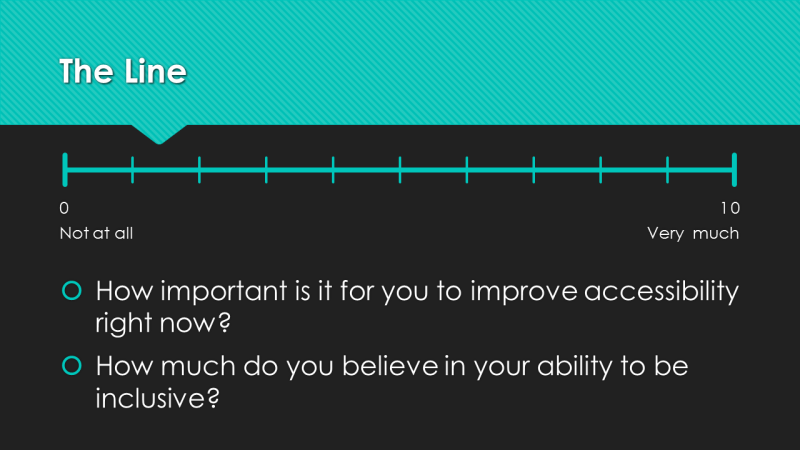
The Line is actually a visual scale, scored from zero to ten, means not at all to very much. We ask two questions: How important is it for you to improve accessibility right now? and How much do you believe in your ability to be inclusive? We ask about the score and then why. We may continue to discuss the score with more information to come to a mutually satisfactory conclusion. If the first score is low, we explore the reason, including what other conditions may change the score. If the first score is high but the second score is low, we can provide information on how to improve their ability. If both scores are high, they usually move into the next phase.
線條工具其實就是個視覺量尺,從 0 分到 10 分,分別代表從「完全沒有」到「非常多」。我們會問兩個問題:
- 貴機關覺得現在改善親和力有多重要?
- 貴機關對於自己包容友善的能力,有多少信心?
我們詢問過機關自己給的分數後,接著追問為什麼是那個分數。我們可能提出更多資訊,接續討論這兩個問題的分數,直到我們跟機關雙方都對分數達成共識。如果第一題的分數很低,我們將探索低分的原因有哪些,包括是否有其他條件或因素可能在現在或將來會造成分數改變;如果第一題的分數很高,但第二題的分數很低,我們可以提供有哪些增強機關能力的資訊。如果兩題的分數都很高,通常機關就能進入下一個階段。
![Slide: [Phase 2] Preparation](https://jedi.org/blog/archives/ABMAMTTIA-13.png)
When the agency determines their service needs to be accessible, they are in phase two, Preparation. In this phase, we can offer advice on possible strategies, guidelines, options, and steps. Usually, they will have many questions, for them, it's an exciting new journey ahead. Some agencies may continue to express ambivalence in this phase. This time, we can use the next motivation tool, the Box, to help them.
當政府機關確信其提供的服務應親和易用,就表示機關已經處於第二階段:準備期 (Preparation)。在這個階段中,我們提供可能的策略、指引、選項、步驟等建議。通常處於這個階段的政府機關會拋出許多問題,對這些機關而言,即將展開興奮的嶄新旅程。有些機關在這個階段可能又冒出一些內在矛盾而顯得猶豫,這次我們要用方格動機諮商工具來協助機關。
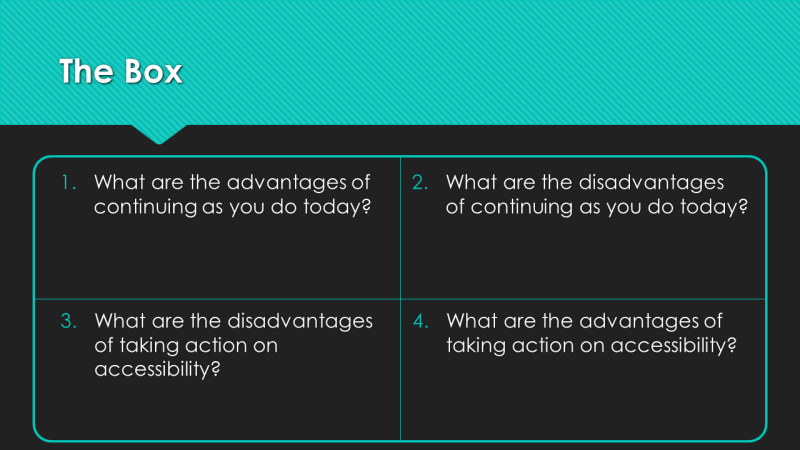
The Box contains four quadrants, with one question in each. Usually we focus on the first two questions, the latter two if there is time available. Through these questions, we help them explore the advantages and disadvantages of doing nothing at all, and taking action. We write these answers down, with their own words, usually by online collaboration tools such as Google Docs, then discuss and explore with them. Once they put their mind to taking action, they move into the next phase.
方格包含四個象限,每個象限裡有一條題目,通常我們先聚焦在前兩條題目,如果時間允許再進行後兩條。我們利用這些題目,協助政府機關探索「什麼都不做」的優點跟缺點,以及「做出改變」的優點跟缺點。我們會依照政府機關自己的話語把這幾條題目的回答寫下來,通常是利用 Google 文件等線上共筆工具讓彼此一起參與,然後再一起討論跟探索這些回答。一旦政府機關下定決心要做出改變,就能進入下一個階段。
![Slide: [Phase 3] Action](https://jedi.org/blog/archives/ABMAMTTIA-15.png)
From phase three, Action, the Behavioral Process starts. We shall take their views and needs, develop a joint strategy with them to drive this accessibility journey. The important part of this phase is to encourage them by highlighting their benefits of improved accessibility. With positive reinforcement, they can grow accessibility and move into the next phase.
從第三個階段,即行動期 (Action)起,進入行為改變的行為歷程。我們應該考量政府機關的觀點及需求,一起合作發展出聯合策略,驅動這趟親和力旅程。這個階段的重點是要盡量彰顯親和力已經改善的部份確實帶來哪些效益,由此鼓勵政府機關;利用這種正向增強,政府機關就能孕育親和力茁壯,進入下一個階段。
![Slide: [Phase 4] Maintenance](https://jedi.org/blog/archives/ABMAMTTIA-16.png)
In phase four, Maintenance, the agency acts as accessibility is a priority, and keeps doing so. We may ask how they are managing accessibility, share knowledge and information, answer their questions, provide furthur support. If they are ambivalent, then use the Box to explore their situation. Keep supporting them with positive reinforcement; they may achieve permanent change.
當政府機關處於第四個階段,即維持期 (Maintenance),可以看到其實際作為把親和力視為要件,並持續如此。我們可以詢問機關如何掌握親和力作為,彼此分享知識及資訊,回答機關進一步的提問、提供更深入的支持。萬一政府機關在這個階段流露出內在矛盾,還是可以回頭使用方格工具協助機關探索狀況如何。持續以正向增強提供支持,機關就有機會達到持久改變。
![Slide: [Phase 5] Relapse](https://jedi.org/blog/archives/ABMAMTTIA-17.png)
Some agencies, however, after a period of Maintenance, feel "it's done already." In this Relapse phase, they stop taking action, and their motivation declines. Don't panic; let's listen to them and explore their positive experience with accessibility, remind them of all those good we have made and still can make. We shall use the Line and the Box again if they continue to express ambivalence. With our continued support, they can move into the Contemplation phase and start all over again.
然而,有些政府機關在一段維持期之後,開始覺得「都做完了」,而開始故態復萌 (Relapse),停下親和力相關作為,動機逐漸衰退。遇到這樣的機關也別慌,我們需要傾聽機關訴說的經驗,從中探索親和力的正向體驗,提醒機關我們已經達成哪些效益,而且這些效益還能持續開創。如果機關仍然浮現更多內在矛盾,我們可以再回頭拿出線條及方塊工具,不要放棄,持續支持,機關可能再次進入意圖期而重新踏上行為改變。

In this year, most government agencies we reviewed are at phase zero to two, all in the Attitude Process. It takes time for agencies to shape their idea and attitude. PDIS is not the magic wand. I can not wave my hand to make accessibility happen as in the Star Wars movies. PDIS is here, to empower Taiwan's government agencies, enrich our culture, and help Taiwan become more inclusive and accessible. May the Force be with us all.
我們在今年協助過的政府機關中,絕大多數都處於第零階段到第二階段,全部處於行為改變的態度歷程。政府機關需要相當的時間才能塑造出相關的認知及態度。PDIS 並不是什麼魔法杖,我也沒辦法像電影中的絕地武士那樣揮個手就讓親和力普及。PDIS 在此的意義與目的,是要賦權台灣的政府機關,豐富台灣的公部門文化,協助台灣更加包容友善。願原力與你我同在。
註:我在上述這段分享中,提到這些模型、工具、技巧借鏡健康照護領域,有興趣的夥伴不妨移駕我之前的另一篇文章《在輔具中心提供以人為本的聽覺輔具服務》,我寫了更多細節及技巧可供參考。